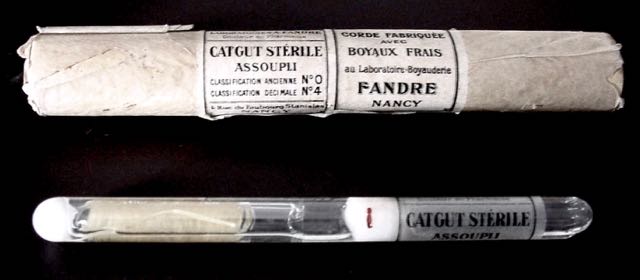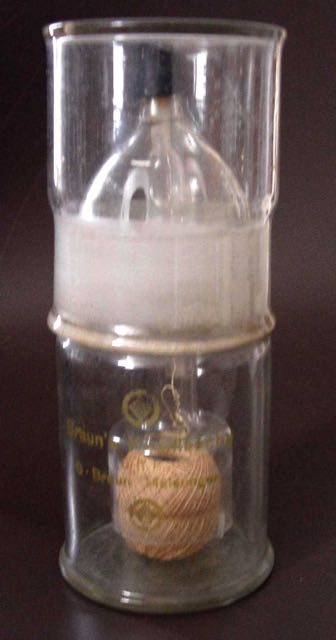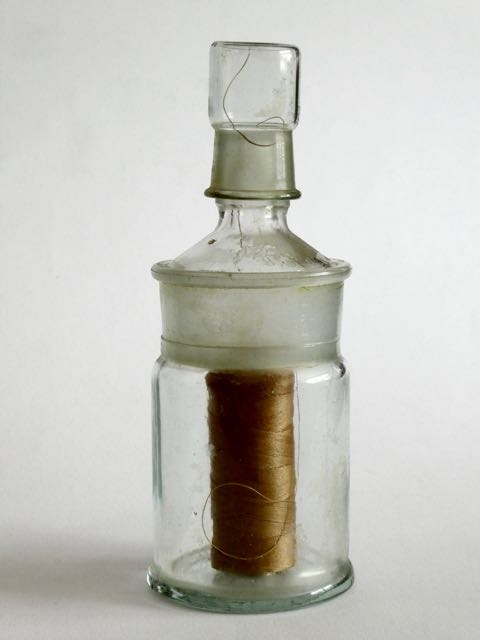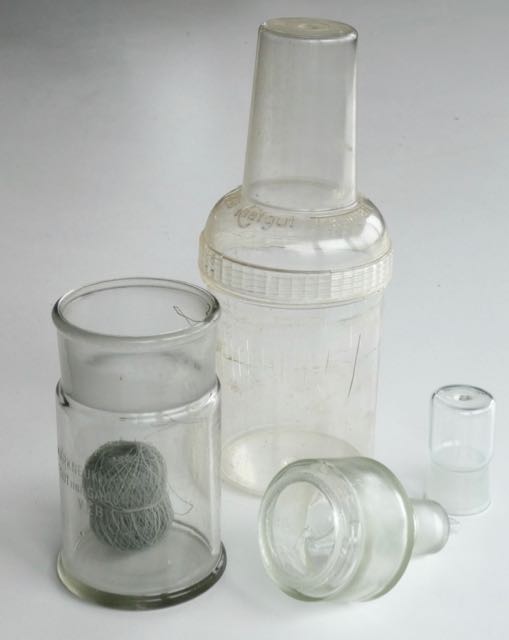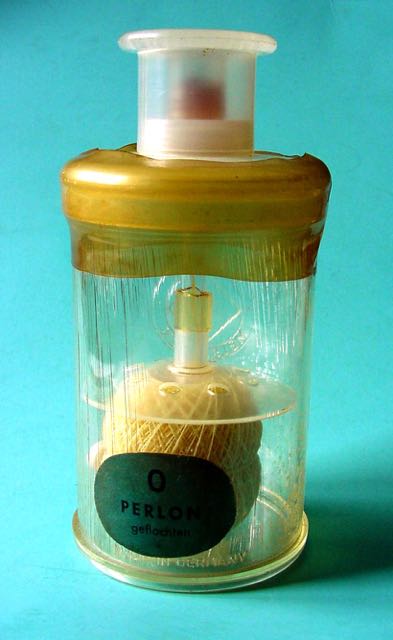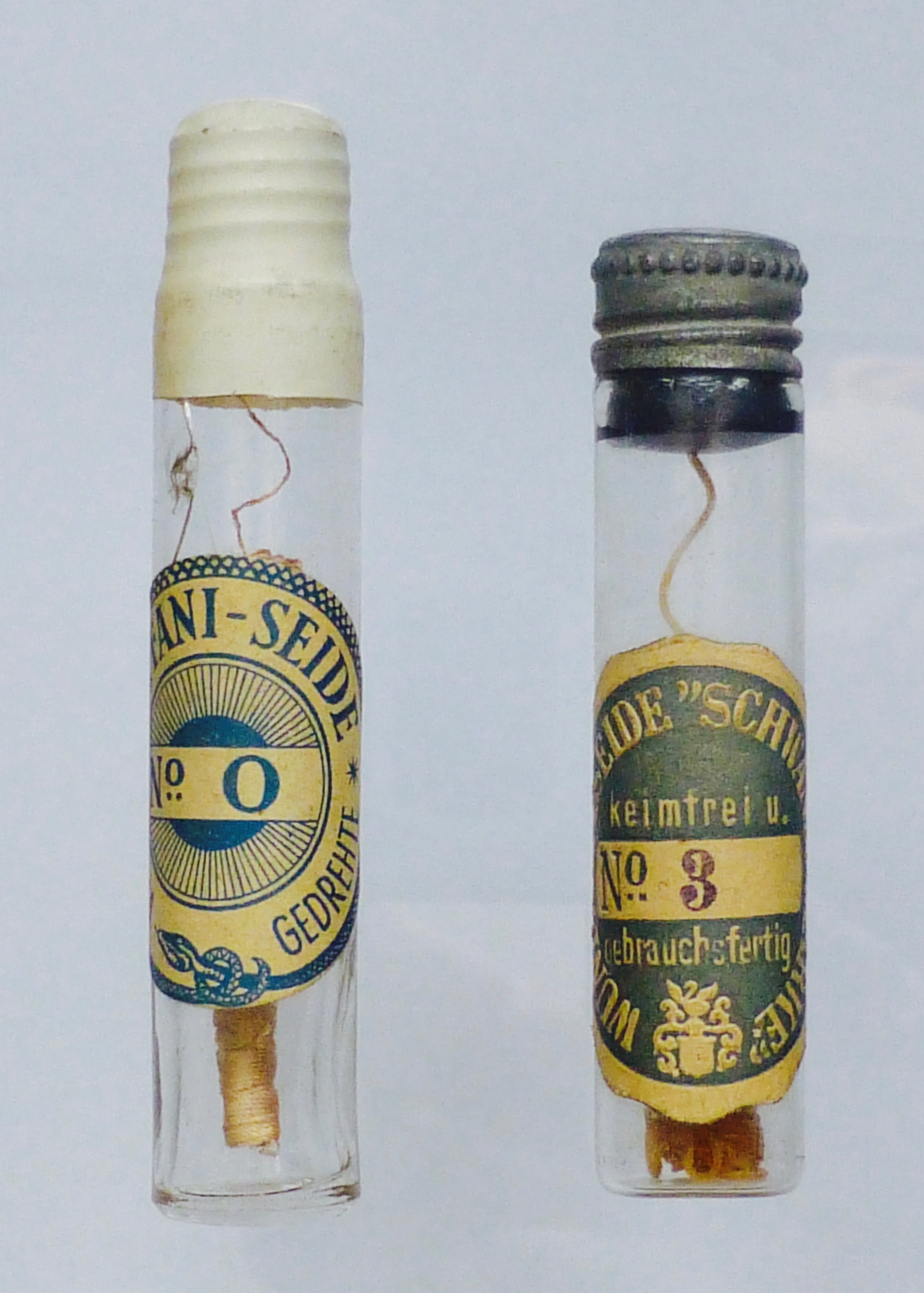Surgery |
||
Thread Catgut (1) |
||
For gut strings in English until today the misleading term "Catgut" (= cat gut) is common. The originof this term is explained by an anecdote: around 1300 Italian saddlers discovered in the small town of Salle / Pescara that the intestines of the wild mountain sheep of the region, which they used to sew the saddle, were particularly suitable as a string for musical instruments. The string production quickly became the most important industry of the place. In order to protect against competition, the true origin of the intestinal material used by them was concealed, and claims that it is cat gut. Back then, there were some superstitions about cats, and the killing of cats was regarded as unfortunate - so it was hoped to deter potential imitators.
|
Surgery |
||
Thread Catgut (2) |
||
Box with catgut threads of the Laboratoires BRUNEAU & Cie, 17 r. de Berri, Paris. Catgut N ° 4 "filière décimal N ° 8, stérilisé et assoupli" (1953).
The fact that catgut did not satisfy all surgeons' wishes was shown by the fact that Marion SIMS (1813-1883) from New York introduced the suture with silver wire, and Gustav SIMON (1824-1876), professor of surgery in Rostock and Heidelberg, who Suture with horse hair introduced - and even today, new suture material is invented. |
Surgery |
||
Thread Catgut (3) |
||
As the first specific surgical material came in 1860 the "Carbol catgut" after Joseph Lister (1827-1912) on the market, by treatment with sublimate sterilized intestine.
It was not until 1908 that the production of really sterile Cat succeeded: the small manufactory of Carl Brau took a significant turn in 1908 towards industrial operation when Brauun gave the surgeon Dr. Ing. Franz KUHN (1866-1929) met. He was looking for a company that was ready to produce the catgut he had developed. Braun began production of "Sterile Catgut Kuhn," a resorbable suture based on the mutton intestine. This soon proved to be an entrepreneurial stroke of luck and brought a tremendous boost to the small business. Production started on an industrial scale in 1909 when BRAUN expanded its chemical-pharmaceutical manufacturing facility and processed hammock arms into sterile sutures.
In 1928, Johnson & Johnson developed a special catgut thread under the name ETHICON, which was registered as a patent in 1930, but only gained market share after 1942, when the thread was more in line with US FDA regulations than similar products from the competition. The production of the ethicon thread was so successful that it was soon outsourced to a subsidiary, the "ETHICON Suture Laboratories".
Exhibit On French flea markets you can occasionally find this product from Lorraine: "Laboratoires A. FANDRE
|
Surgery |
||
Thread: Chromcatgut (1) |
||
The disinfected Catgut was supplemented in 1881 by Chrom-Cat, in which the thread was tanned with chromic acid to double the absorption time to 2-3 weeks.
- an invention of the great John LISTER (1827-1912) ... |
Surgery |
||
Thread: Chromcatgut (2) |
||
This chrome catgut thread "Ethicon Obstetrical Surgical Good Type D Extra-Chromic Eyeless Needle N ° 3, 30 inches" from Johnson & Johnson was developed especially for the needs in the delivery room. The Serti needle should minimize tissue traumatization.
The "aiguille sertie" had already been invented in 1874 by an op-nurse (who probably was tired of threading the needles of the boss) - the first such needle was called "EUREKA".
|
Surgery |
||
Thread donor (1) |
||
Refillable surgical thread dispenser (H: 16 cm, D: 6.5 cm) from Braun Melsungen (around 1951). The 100 meter long thread lay in a disinfected liquid. Each time before use, the bottle was tilted (hence the name "tilting bottle") and thus disinfected the end of the thread. Thereafter, the lid was opened and removed suture, then closed and disinfected by tipping again.
pressed glass
Thread dispenser with "thick head" |
Surgery |
||
Thread donor (3) |
||
Refillable Surgical Thread Dispenser (1981). VEB Catgut Traumafil, Markneukirchen. |
Surgery |
||
Thread donor (4) |
||
With "plastic times" approached the end of the tipping bottles.
The content, however, was revolutionary: PERLON! The development of modern medical sutures and ligatures had begun shortly before the outbreak of World War II with the discovery of polyamide 6 (Perlon) - a substance that became famous in the context of tights. With the development of the original textile fibers PERLON and nylon before the Second World War, the era of fully synthetic threads with high breaking strength, suppleness and first-class knotting properties began.
The ever thinning threads and the stepless - "atraumatic" - connection of needle and thread allow the surgeon today, his masterful "business card" - as such is still the visible scar in many patients - left on the patient.
Exhibit Plastic tipping bottle, Perlon thread braided O |
Surgery |
||
Thread silk (1) |
||
The great Arabian surgeon ABU AL-QASIM AL-ZAHRAVI (Albucasis) (936-1013 CE) was possibly the first to use silk thread as a surgical suture.
Not to medical suture were the adhesive threads of the silk shell: the so-called Byssos threads were extremely expensive and found at most in cult objects, e.g. in the making of images of saints [Vera.icon> Veronica-Schweisstuch] Use.
From England comes this old pack of non-sterile packaged "Plaited Silk", i. braided silk threads. Involuntarily one thinks of the surgeon Mathias GRECHEN (1857-1919) from Luxembourg, who also received such material from England, when he carried out the first ovariotomy in Luxembourg in the autumn of 1884 ... |
Surgery |
||
Thread silk (2) |
||
|
Surgery |
||
Thread silk (4) |
||
A whole series of today forgotten companies supplied the market with supposedly sterile silk, so
- the "Schwanenmarke" (right in the picture),
- Paul Ruffani "Permanent Exhibition & Shipping of Articles on Health & Nursing, Frankfurt a.M., Friedensstrasse 8, now Bethmannstr.16", supplied in March 1893 German clinics with turned RUFFANI silk. In 1934 he was in Frankfurt, Alte Rothhofstrasse 4, manufacturer of sutures (left in the picture). |






